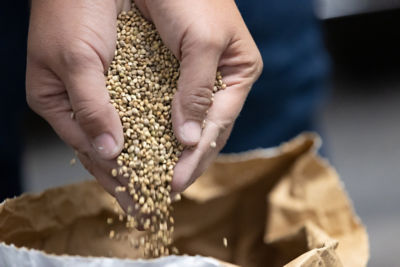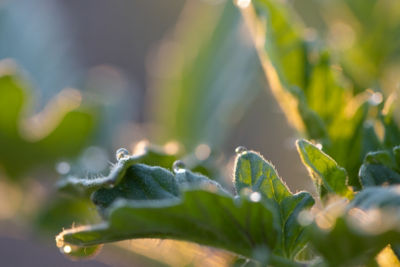Click here to download a PDF version of this spotlight.
» Pythium diseases cause substantial damage to seeds, seedlings, and older bean and pea plants.
» Several species of Pythium are important pathogens in bean and pea production.
» Seed treatment fungicides and the use of cultural practices can help manage Pythium diseases.
Several species of the water-mold pathogen Pythium can infect garden beans and peas, causing below- and above-ground diseases, including seed rot, pre- and post-emergence damping-off, stem rot, root rot, aerial blight, and pod rot (cottony leak).1,2,3 Pythium species are the most common causes of seed and seedling diseases of peas, and Pythium diseases cause major damage to both beans and peas, affecting roots, stems, leaves, and pods.2,4 These pathogens are widely distributed in bean and pea-growing regions, causing substantial reductions in yield. Pythium pod rot is becoming an increasing problem for processing snap bean production in some growing areas.5
SYMPTOMS
Beans: Both below ground and above ground (foliar) Pythium diseases occur on beans. With both seed rot and pre-emergence damping-off the bean seed, radicle, and hypocotyl tissues discolor and become soft and mushy, and seedlings fail to emerge. With post-emergence damping-off, seedlings wilt and die after emergence, with water-soaked lesions developing on roots and/or the hypocotyl at or below the soil line (Figure 1). Seed rot and damping-off result in reduced plant stands. Seedlings that survive often show reduced growth with smaller and necrotic root systems. Mild feeder-root infections can result in reduced plant productivity with no above-ground symptoms.1,4,5
Above ground diseases include basal stem rot, aerial Pythium (Pythium blight), and Pythium leak, where water-soaked lesions develop on stems, leaves, and pods (Figure 2). Leaves on infected plants can detach, resulting in stunted plant
 Figure 1. (A) Heavier soils and higher application rates allow water to move horizontally through the soil more quickly. (B) In lighter soils or with lower application rates, water tends to move downward in the soil.
Figure 1. (A) Heavier soils and higher application rates allow water to move horizontally through the soil more quickly. (B) In lighter soils or with lower application rates, water tends to move downward in the soil.
 Figure 2. A snap bean showing symptoms resulting from infection by Pythium sp. Howard Schwartz, Colorado State University, Bugwood.
Figure 2. A snap bean showing symptoms resulting from infection by Pythium sp. Howard Schwartz, Colorado State University, Bugwood.
With pod infections, sometimes called Pythium leak or cottony leak, water-soaked lesions and white, cottony, thread-like growth develop on the pods. Basal pods and pods in contact with the soil are most likely to become infected. Severe infection in a field can result in the rejection of the crop by buyers and processors, and the disease can spread to adjacent pods in storage.
Peas: In pea, Pythium only causes the seed- and root-rot phases. As with beans, infection of peas results in a watery soft rot of affected tissues. Seed rot and pre-emergence damping-off can occur soon after planting, resulting in reduced plant stands. Rotted seeds may be encased in a layer of soil. Post-emergence infections are often limited to the tips of feeder roots, resulting in root pruning, reduction in the number of secondary roots, and a reduced root mass. Infections initiated below the soil line can spread upward and downward on the plant. White, cottony growth can develop on affected tissues when humidity levels are high. Affected plants are often stunted, lack vigor, and show reduced yields.2,3
THE PATHOGEN
Pythium species that cause diseases on beans and peas occur in most soils where these crops are grown. The genus Pythium is a member of the oomycete group of fungal-like organisms, also called water molds. Several Pythium species cause disease on beans and peas. Pythium ultimum, P. irregulare, P. myriotylum, and P. aphanidermatum are the most commonly occurring pathogens of beans and peas. Some of the species were recently moved into different genera and have been renamed. For example, Globisporangium ultimum is the new name for Pythium ultimum; however, for simplicity, we will continue to use the name Pythium for all the pathogens in this article. Some of the species have wide host ranges, while the ranges of others are narrower.2,6,7
CYCLE AND CONDITIONS
Pythium spp. are common soil inhabitants that survive in soil and plant debris as spores and structures called sporangia. Oospores are thick-walled and can survive in the soil for several years. Sporangia can survive in the soil for several months to a year. The pathogens are spread in infested soil on equipment, in water, and by wind. Spores and sporangia are stimulated to germinate by exudates given off by nearby roots. When sporangia germinate, they produce zoospores that swim in films of water to reach host roots. Pythium species are most active in moist soil and high humidity conditions, and disease levels usually increase with increasing soil moisture and relative humidity.1,2,3,5 Pathogen activity is also affected by soil temperature. Some species, such as P. ultimum and P. irregulare are most active in cooler soils (40° to 50°F, 5° to 10°C), while species such as P. aphanidermatum are more active in warmer soils (77° to 86°F, 20° to 30°C). However, even diseases caused by warm temperature Pythium species may be more severe during cooler weather because lower temperatures slow germination and rates of seedling development. Seedlings become more resistant to infection as they develop, so cooler temperatures increase the amount of time seedlings are most susceptible to infection.1,2,7 Pythium infections can occur throughout the season, but infections of older plants usually only develop when conditions are very favorable with abundant moisture. Basal stem rot and Pythium blight can spread with splashing water, infecting lower leaf nodes when periods of leaf wetness last from 48 to 72 hours.5 Bean pod infections are also most severe during humid conditions when pods are in contact with the soil.4
MANAGEMENT
Control strategies for seed decay and damping-off focus on the use of seed-treatment fungicides and cultural practices to reduce the chances of infection. Seed treatments containing systemic products specifically effective against oomycetes, including metalaxyl and mephenoxam, have shown to be highly effective for managing these diseases. However, strains of Pythium spp. with resistance to these fungicides have been detected in some regions of the U.S.1,2,3
Biological control agents, such as Burkholderia cepacia, Streptomyces griseoviridis, Gliocladium virens, and Trichoderma harzianum have been evaluated for controlling Pythium diseases on beans and peas. However, the effectiveness has been less consistent than management with chemical fungicides. Biological control agents and chemical seed treatments can sometimes be used together. Always read and follow label directions.
Cultural practices can also help lower disease incidence and severity. Growers should avoid heavily infested fields and rotate to non-host crops. To increase the speed of germination and increase seedling vigor, avoid low-lying, poorly drained areas or improve soil drainage to minimize wet soil conditions. Reduce soil compaction and improve soil tilth. Delay planting until soil temperatures warm to above 50°F (10°C). Plant seeds in a well-prepared seed bed, and place seeds deep enough to have seed in contact with moist soil, but not so deep that germination and emergence will be delayed. Planting on raised beds can improve drainage and increase soil warming early in the season. If possible, avoid irrigating immediately after planting. Use seed lots with good vigor and rapid germination, especially if planting into cool, moist soil, in areas with a history of Pythium disease problems, or for organic production where effective seed treatments may not be available.1,2,3,6
Resistance to Pythium diseases is not generally available in garden beans and peas. Some differences in susceptibility have been observed among bean varieties, but no commercially available cultivars are claimed to be highly resistant.5 Some dark-colored seed varieties tend to be less susceptible to seed rot and damping-off than lighter-colored seed varieties. However, some white-seeded snap bean lines have also been found to be less susceptible.1 In peas, wrinkle-seeded varieties tend to be more prone to infection than smooth-seeded varieties, possibly because of increased sugar levels in exudates leching out of the seed of wrinkle-seeded varieties.2
SOURCES
1 Pfender, W., Hagedorn, D., and Harveson, R. 2005. Pythium diseases. In Compendium of Bean Diseases, Second Edition, Schwartz, H., Steadman, J., Hall, R., and Forster, R., Editors. The American Phytopathological Society. Ppg 17-19.
2 Paulitz, T., Schroeder, K., Porter, L., Chen, W., and du Toit, L. Pythium seed and seedling rot. In Compendium of Pea Diseases and Pests, Third Edition, Harveson, R., Pasche, J., Porter, L., Chen, W., and Burrows, M., Editors, The American Phytopathological Society. Ppg. 23-26.
3 Bost, S. 20026. Root rots and seedling disease of beans and peas. Plant Diseases, University of Tennessee Extension. SP277-0.
4 2021. Bean diseases: Pythium leak. UF-IFAS U-scout. https://plantpath.ifas.ufl.edu/u-scout/bean/pythium-leak.html#:~:text=Pythium%20leak%20 of%20beans%20can,move%20rapidly%20in%20the%20field.
5 Damicone, J., Olson, J., and Kahn, B. 2018. Cultivar and fungicide effects on Pythium leak of snap bean. Plant Health Progress https://doi.org/10.1094/PHP-2012-0418-01-RS.
6 Frate, C., Gepts, P., Long, R. 2018. UC IPM pest management guidelines: dry beans. UC ANR publication 3446.
7 Alcala, A. V. C., Paulitz, T. C., Schroeder, K. L., Porter, L. D., Derie, M. L., & du Toit, L. J. 2016. pythium species associated with damping-off of pea in certified organic fields in the Columbia basin of central Washington. Plant Disease, 100(5), 916–925.
Websites verified 6/6/2023
ADDITIONAL INFORMATION
Performance may vary from location to location and from year to year, as local growing, soil and weather conditions may vary. Growers should evaluate data from multiple locations and years whenever possible and should consider the impacts of these conditions on the grower’s fields. The recommendations in this article are based upon information obtained from the cited sources and should be used as a quick reference for information about vegetable production. The content of this article should not be substituted for the professional opinion of a producer, grower, agronomist, pathologist and similar professional dealing with vegetable crops.
BAYER GROUP DOES NOT WARRANT THE ACCURACY OF ANY INFORMATION OR TECHNICAL ADVICE PROVIDED HEREIN AND DISCLAIMS ALL LIABILITY FOR ANY CLAIM INVOLVING SUCH INFORMATION OR ADVICE.
5111_248950 Published 06/26/2023




